Mission blog
In an effort to keep you informed about Chris Hadfield's mission, we will be publishing weekly mission highlights.
Final CSA mission blog May 10–16, 2013
-
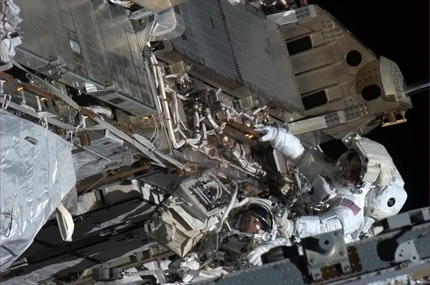
Hadfield via Twitter: "Here's looking at you. Chris and Tom take a minute with visors to look up-sun at my camera in the window." May 11, 2013. (Credit: Canadian Space Agency/NASA)
-

Hadfield via Twitter: "Spaceflight finale: To some this may look like a sunset. But it's a new dawn." May 13, 2013. (Credit: Canadian Space Agency/NASA)
-
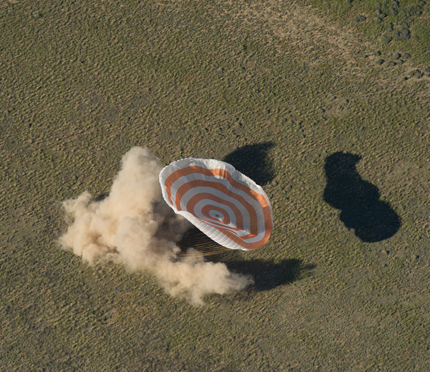
The Soyuz TMA-07M spacecraft touches down in a remote area near the town of Zhezkazgan, Kazakhstan, on May 13, 2013. (Credit: NASA/Carla Cioffi)
-
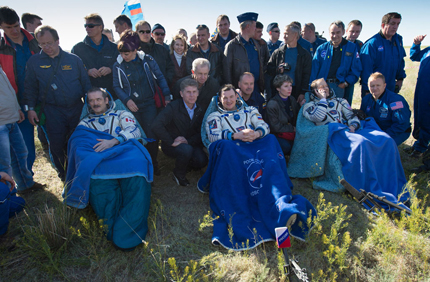
The Expedition 34/35 crew resting in chairs just minutes after landing in Kazakhstan. May 13, 2013. (Credit: NASA/Carla Cioffi)
-
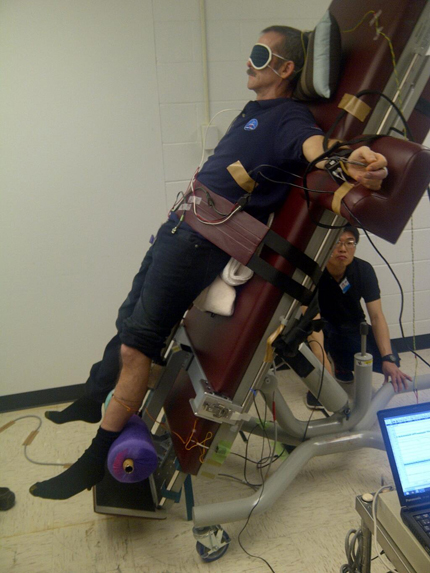
Hadfield via Twitter: "How does the body control blood pressure? Scarecrow on a tilt table to measure how." May 15, 2013. (Credit: Canadian Space Agency/NASA)
In story book fashion, CSA astronaut Chris Hadfield returned to Earth after a five-month mission that rekindled for thousands – if not millions - their wonder, curiosity and passion for space exploration. Hadfield did not just come back to Earth – he brought space with him, for everyone.
Accompanied by his crewmates NASA astronaut Tom Marshburn and cosmonaut Roman Romanenko in their Soyuz TMA-07, the three touched down on the steppe of Kazakhstan at 10:31 p.m. EDT on May 13, 2013. Hadfield was the last of the three to be pulled out of the scorched remains of their capsule, but was all smiles and thumbs up to the rescue crew and media who greeted him.
Their return was not without a touch of drama, however, as a few days prior an ammonia leak was detected on the exterior of the International Space Station (ISS). Unsure of the cause, it was considered quite possible that their undocking with the ISS could be delayed. However, on May 11, NASA astronauts Tom Marshburn and Chris Cassidy got into their spacewalking suits and went to work, replacing a leaky pump in just under three hours.
The next day, Hadfield handed over command of the Space Station to colleague and long-time friend Pavel Vinogradov, ushering in the end of Expedition 35.
Before leaving the Station, Hadfield's son Evan released Chris' revised version of a Space Oddity, filmed almost exclusively throughout the modules of the Station. It was an immediate viral hit and sits at just under 13 million views at the time of this writing.
Going out on a high note, Hadfield is now rehabilitating in Houston, having been flown there soon after his landing in Kazakhstan. After five months in weightlessness he must readapt to a life where mics fall when let go, and even speaking feels different as the tongue has weight again. To find out more about the physical challenges Hadfield is going through, please see our flight surgeon's updates on these matters.
On May 16, Hadfield performed his first news conference since returning to Earth, sharing his impressions of the mission and much more in his eloquent, thoughtful manner.
During five months in space, Hadfield became Canada's first Commander of the International Space Station, performed over 130 science experiments, operated Canadarm2, and was at the centre of an integrated outreach campaign spearheaded by the CSA that captured headlines and hearts around the world. The mission was a success on every level, and will serve to inspire the next generation of Canadian and international scientists, astronauts, engineers and artists. While on orbit, Hadfield reflected on the mission, expressing his sense that this was a shared experience between himself and the people of Earth.
To see how this historic mission unfolded, please go to our Expedition 34/35 page and our social media channels. Keep in mind, we will also be posting more videos, photos and updates of Chris Hadfield's recovery and re-adaptation to Earth. Thank you for following!
At a glance
Highlights from the CSA's integrated outreach campaign for this mission include:
- Engaging students across the country every week through video connections and amateur radio contacts, reinforcing the importance of a sound education and disciplined work;
- Enlisting CSA astronauts David Saint-Jacques and Jeremy Hansen to support these events and expand their reach;
- Producing over 146 videos that have been viewed over 25 million times;
- Announcing the winners of the CSA high school science contest. His spellbinding demonstration of the winning experiment on surface tension has been viewed by millions;
- Singing, with close to a million people across Canada and around the world, mostly students, live from space for Music Monday;
- Launching an interactive learning website on space with the National Film Board;
- Collaborating with Let's Talk Science, allowing over 7000 high school students in 300 classrooms across Canada to perform the same experiment on radiation as Chris Hadfield on orbit;
- Unveiling Canada's new $5 bank note, which features Canadian robotics;
- Speaking with remarkable Canadians like His Excellency the Right Honourable David Johnston, Governor General of Canada, Canada's Prime Minister Stephen Harper and actor William Shatner;
- Publishing this weekly mission blog;
- Launching a Canadarm2 game (developed in part by the same robotics simulator used by astronauts to train at the CSA headquarters), allowing "armchair astronauts" to test their robotics skills;
- Actively engaging with the public through CSA's social media accounts, live-tweeting events and critical mission operations, and organizing three mission-related CSATweetups;
- Reaching over 967,000 followers on Twitter and 351,000 on Facebook as of this writing (Chris Hadfield's accounts only).
May 3-9, 2013
-
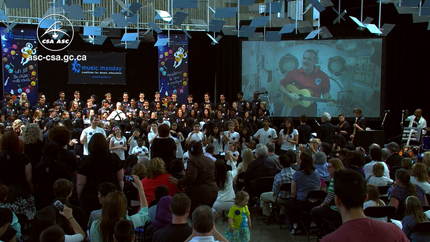
The Music Monday live event at the Ontario Science Centre, from space to Earth. Nearly one million students from coast-to-coast Canada and around the world sang along with Hadfield to his and Ed Robertson's song, I.S.S. (Is Somebody Singing). May 6, 2013. (Credit: Canadian Space Agency)
-

Hadfield via Twitter: "Good to know that after 5 months, my Sokol pressure suit still fits. It's what we wear in the Soyuz. High fashion." May 7, 2013. (Credit: Canadian Space Agency/NASA)
-

Hadfield via Twitter: "Tonight's Finale: Moonset, one of 16 per day on ISS, all marvellous to see." May 7, 2013. (Credit: Canadian Space Agency/NASA)
-
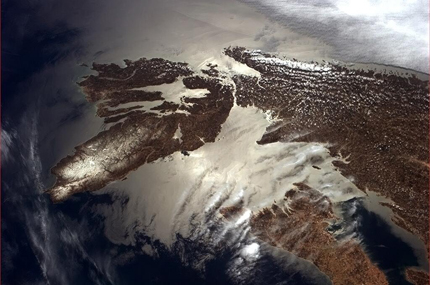
Hadfield via Twitter: "The highlands of Cape Breton still wear the winter's snow, sun highlighting the connecting waters." May 5, 2013. (Credit: Canadian Space Agency/NASA)
As incredible as it may seem, this was the last full work week of CSA astronaut Chris Hadfield's Expedition 35. Putting a final exclamation mark on his mission before returning to Earth this upcoming Monday night, the first Canadian commander of the International Space Station (ISS) performed the last of his live video downlinks, a collaboration between the CSA and the Coalition for Music Education for Music Monday 2013.
Hadfield led students at the Ontario Science Centre and nearly a million enthusiastic earthlings from Canada and around the world in I.S.S. (Is Somebody Singing), a song he co-wrote with Barenaked Ladies' front man Ed Robertson. The event proved to be sheer magic, and elicited heartfelt sentiment from Hadfield.
In preparation for his return, Hadfield was reacquainted with his Sokol pressure suit, donning it to make sure it still fit and that there were no leaks. He and crewmate Roman Romanenko also tested the thrusters and motion control system of their Soyuz capsule, the reverberations being felt throughout the Space Station. All tested well, and the 33-Soyuz crew completed two successful Soyuz descent drills.
In terms of science, Hadfield and Tom Marshburn performed their third and final spinal ultrasound to observe changes to the spine during and after spaceflight. Hadfield also took part in the Pro K nutrition experiment, which strives to assess and reduce bone loss experienced by astronauts in weightlessness. The Commander also took water samples from various water systems on board the Station to test for microbes. The samples will return with him on the Soyuz.
The shutterbug in Hadfield was also kept busy this week, not just in taking his own breath-taking photos, but also in implementing a firmware upgrade and session for the European Space Agency's NightPod experiment, which aims to improve night photography of the Earth from the ISS. Hadfield also conducted cooling loop maintenance of the ISS' space walking suits. You can watch him stow a couple of suits in this video. The CSA also published, every workday this week, a video on one of the five senses and the way they are affected in space. Our videos featuring Chris Hadfield continue to be popular among teachers and our followers. Even Popular Mechanics thinks "You Should Watch Chris Hadfield's YouTube Videos".
Commander Hadfield also performed an amateur radio contact with students from Hay River, Northwest Territories. On May 11, he will be taking part in the last of 15 amateur radio connections with a group of residents, students and a traditional aboriginal elder from Yellowknife, N.W.T.. The Canadian Space Agency wishes to sincerely thank the ARISS Canada team for helping us reach out to thousands of students and many communities in all provinces and territories during this mission.
Coming up: On the 12th the change of command ceremony takes place as Canada's first ISS Commander passes his title on to long-time friend and colleague, cosmonaut Pavel Vinogradov. And finally, on the night of the 13th, Hadfield returns to Earth after an inspiring five-month mission in which the most hours of science in a single week ever performed on the ISS were conducted and over three-quarters of a million people followed his tweets—among many other measures of success achieved.
For the latest news about Hadfield's mission, visit our Expedition 34/35 page and see our social media, including our new Tumblr page.
April 26-May 2, 2013
-
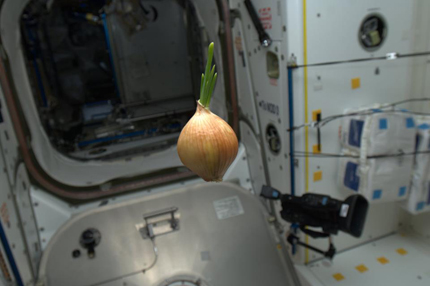
Hadfield via Twitter: "Space Onion - came up on the Progress resupply spaceship. We sliced it up and had it with everything - nice flavor!" May 2, 2013. (Credit: Canadian Space Agency/NASA)
-
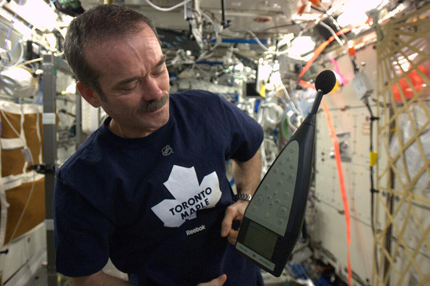
Hadfield via Twitter: "Tricorder? Our sound level meter has a very Space Age look." May 2, 2013. (Credit: Canadian Space Agency/NASA)
-

Hadfield via Twitter: "An astronaut's perspective on the Canadian Maritimes." April 30, 2013. (Credit: Canadian Space Agency/NASA)
-
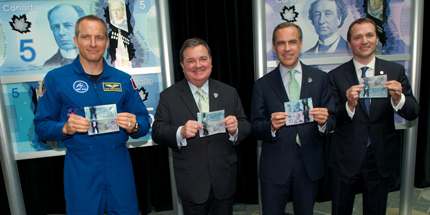
Unveiling the new $5 and $10 dollar bills: From left to right, CSA astronaut David-Saint Jacques, Minister of Finance Jim Flaherty, Bank of Canada Governor Mark Carney and Chairman of the Board at VIA Rail Canada, Paul G. Smith. April 30, 2013. (Credit: Bank of Canada)
-

Hadfield via Twitter: "Tonight's Finale: Beautiful Machine - Canadarm2 on the horizon, awaiting instruction." April 26, 2013. (Credit: Canadian Space Agency/NASA)
-

The permanent display of Canadarm2's predecessor, Canadarm, was unveiled on May 2. It will remain at the Canada Aviation and Space Museum. (Screen capture of CSA webcast by CollectSpace.com)
This week began with the Russian Progress vehicle 51P docking to the International Space Station (ISS), bringing fuel, fresh food, hardware and supplies for the six-person crew. It also provided CSA astronaut Chris Hadfield with an onion to cut into, eliciting tears, but as he explains in this video, ones that don't fall.
Now drawing closer to his departure date, the Commander of the ISS remains as engaged with his activities as ever.
Among his science duties, Hadfield performed a blood draw for the Canadian experiment Vascular, storing his samples in the MELFI freezer. Vascular investigates the effects of long-duration spaceflight on the cardiovascular system of astronauts on the ISS. He also did a camera check and battery change of the colloid experiment BCAT-3, completed his last session of the Reversible Figures in Space experiment, and performed a Panoptic eye exam on NASA astronaut Chris Cassidy, one of many more eye exams to come. See this video to learn more about the tools Chris and his crew mates use to monitor eye sight in space.
Around the Station, Hadfield installed a new payload Ethernet hub to update the ISS' local area network, set up sound level meters to measure the acoustics of the Station, and also started preparations for crew departure.
In neat facts about the ISS, check out these new CSA videos performed by Hadfield: How the Station recycles its water and how it is controlled.
Meanwhile, outside the ISS, Dextre was also busy, tackling tasks such as removing caps, small screws and cutting through thermal blankets for the Robot Refueling Mission.
On the 30th Hadfield had a big day, videolinking in from the International Space Station to the Bank of Canada's head office in Ottawa. He was joined by Minister of Finance Jim Flaherty, Bank of Canada Governor Mark Carney and Chairman of the Board at VIA Rail Canada, Paul G. Smith to unveil the new Canadian $5 bank note, which features Canadarm2 and Dextre, part of Canada's contribution to the International Space Station. Hadfield's wife, Helene, and CSA astronaut David-Saint Jacques were also in attendance.
Hadfield also performed an amateur radio pass with 300 students from Polyvalente Black Lake in Thetford Mines, Quebec, and helped unveil the new Space Shuttle Canadarm exhibit at the Canada Aviation and Space Museum.
In upcoming notable mission events, Hadfield will be joining schools and communities across Canada to sing "I.S.S. – Is Somebody Singing" for Music Monday on May 6, which starts at 12:00 p.m. EDT.
For the latest news about Hadfield's mission, visit our Expedition 34/35 page and see our social media, including our new Tumblr page.
April 19-25, 2013
-

Hadfield via Twitter: "If you fly in space, this is a great group to be with, surrounded by talent: Pavel, Tom, Chris, Roman & Alexander." April 25, 2013. (Credit: Canadian Space Agency/NASA)
-
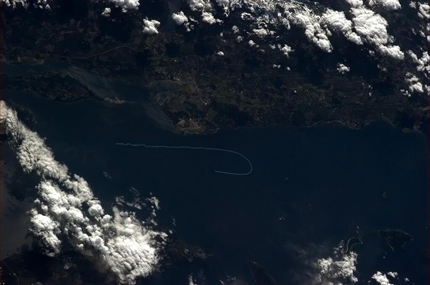
Hadfield via Twitter: "Snowbirds from Space! Canada's premiere aerobatic team, photographed from orbit. Amazingly clear, and great timing!" April 23, 2013. (Credit: Canadian Space Agency/NASA)
-

Hadfield via Twitter: "Space Plumber - replacing a low-temp cooling valve in the Columbus Lab. Note my hi-tech tools." April 25, 2013. (Credit: Canadian Space Agency/NASA)
-
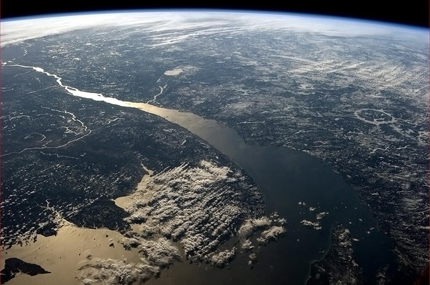
Hadfield via Twitter: "St Lawrence's mouth, where the Great Lakes pour into the sea." April 20, 2013. (Credit: Canadian Space Agency/NASA)
This week Earth Day was celebrated, here on our planet and above it. CSA astronaut Chris Hadfield marked the occasion by taking part in a video downlink with the National Film Board and fellow Canadian astronaut Jeremy Hansen, in which they announced the debut of the NFB's Space School, an interactive website that uses video footage of Hadfield's mission to educate students about space exploration and science.
On the same day another milestone was acknowledged, that of Hadfield's spacewalk on April 22, 2001, the first for a Canadian. Hadfield has often described the experience of viewing Earth from the vantage point of a spacewalk as awe-inducing; fortunately he has been in the position to give us a better sense of this mind-boggling perspective with his pictures of Earth from the Space Station. He's let us in on how he captures these amazing images in this CSA video, featuring Chris during a photo hunt from his perch in the Cupola.
Spacewalks were another highlight of this week, as Russian crewmates Roman Romanenko and Pavel Vinogradov worked on the exterior of the Station. For Roman it was his first such expedition, for Pavel, it was his seventh. He also had the distinction of becoming the world's oldest spacewalker at 59.
Hadfield on the other hand was kept busy inside the Station. This week he began Vascular activities, an on-going Canadian experiment that is investigating the effects of microgravity on the cardiovascular system of astronauts on board the ISS. Dr. Richard Hughson of the University of Waterloo is the Principal Investigator.
Hadfield was also involved in NASA's EarthKAM student project, performing a battery and lens change of its camera. During Expedition 35, EarthKAM set a new record for student participation, involving about 430 school groups with many more pending applications.
And in other record-breaking news, the video of Hadfield performing the student science demonstration of wringing out a washcloth on the ISS has been viewed over six million times—the most of any CSA-released video.
Hadfield also took part in two amateur radio sessions with students from Rankin Inlet, Nunavut and Whitehorse, Yukon, respectively.
And on the horizon, Hadfield and thousands of Canadian students will fill the skies with music on May 6, singing the I.S.S. Song in a special event as part of the the Music Monday initiative.
For the latest news about Hadfield's mission, visit our Expedition 34/35 page and see our social media, including our new Tumblr page.
April 12-18, 2013
-

Chris Hadfield, wearing hardware to monitor his blood pressure, performs a session of the Canadian experiment BP Reg. April 17, 2013. (Credit: Canadian Space Agency/NASA)
-

During a live video event with students from Lockview High School in Fall River, Nova Scotia, Hadfield wrings out a wet cloth to demonstrate surface tension. April 16, 2013. (Credit: Canadian Space Agency)
-
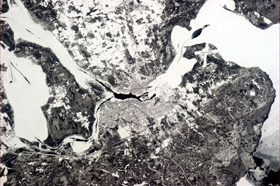
Hadfield via Twitter: "Sault Ste. Marie - vital narrows that lead to Superior. Home of Sault College and Roberta Bondar." April 16, 2013. (Credit: Canadian Space Agency/NASA)
-

While wearing his space jammies, Commander Hadfield shows us how astronauts sleep in space in a recently released video. April 12, 2013. (Credit: Canadian Space Agency/NASA)
Canadian science got a leg up this week as Commander Hadfield performed the first session of BP Reg, a University of Waterloo experiment led by Dr. Richard Hughson. With inflatable cuffs attached to the subject's legs, BP Reg collects data regarding blood pressure in weightlessness. Researchers hope to acquire a better understanding of why some astronauts faint upon their return to Earth. This experiment could also have more general applications, particularly for those with a predisposition to fainting, such as the elderly.
Canadian student science also received Hadfield's attention, as he performed an experiment designed by students from Lockview High School in Fall River, Nova Scotia, as part of the CSA's Canadian Science Challenge. During a live video stream in front of 1200 students from said school, Hadfield squeezed a wet towel, testing the hypothesis by Meredith Faulkner and Kendra Lemke that the water would stick to the cloth due to surface tension. They were proven correct, much to the delight of the audience.
This week also saw the release of two Canadian science and technology videos, one for the blood sample analysis device Microflow, and another for the radiation experiment Radi-N2, an ongoing project that records neutron radiation levels throughout the International Space Station.
Hadfield got a little more physical than usual this week, performing a pre-landing cardio fitness test on CEVIS, the Station's cycle ergometer. He also collected water and urine samples for the Energy experiment.
In other notable activities, Hadfield and Tom Marshburn finished their upgrades to the ISS' new High Rate Communications System, and Hadfield and Chris Cassidy configured cameras for the Russian spacewalk scheduled for this Friday. Hadfield also initiated another session of BCAT-3, a colloid experiment similar to the Canadian experiment BCAT-C1.
As the crew members completed their given tasks, ground controllers powered up the Mobile Servicing System and maneuvered the Canadarm2 into a position to support a video survey of the Pressurized Mating Adapter. Cassidy also took control of the arm to grapple the Mobile Base System Power Data Grapple Fixture 1.
Hadfield had time this week for an amateur radio pass with students in Inukjuak, Nunavik, Quebec and also spoke with 220 grade 9 students from John McCrae Secondary School in Nepean, ON. While wearing his space jammies, he showed us how astronauts sleep in space in this recently released video. On Yuri's Night, April 12, Hadfield and the crew shared a video link with Russia's President, Vladimir Putin.
Coming up in the week ahead, Hadfield will help launch the National Film Board's Space School, an interactive website that teaches students about space exploration and science through the Expedition 34/35 mission. The launch will be hosted by CSA astronaut Jeremy Hansen at the Discovery Centre in Halifax with 105 students from grades 6 to 9 set to attend.
For the latest news about Hadfield's mission, visit our Expedition 34/35 page and see our social media, including our new Tumblr page.
April 5-11, 2013
-
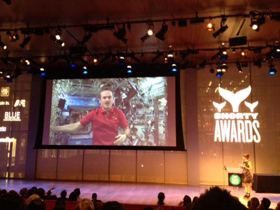
Chris Hadfield accepts his Shorty Award in the Science Category. April 8, 2013. (Screen capture taken by the Canadian Space Agency)
-

Hadfield via Twitter: "Space Haircut, before and after. Tom did a nice job! Just ignore the temperature probe taped to my forehead..." April 7, 2013. (Credit: Canadian Space Agency/NASA)
-

Hadfield via Twitter: "Winnipeg, Manitoba, incredibly clear. The river floodway diversion looks smart from space." April 4, 2013. (Credit: Canadian Space Agency/NASA)
-

Hadfield via Twitter: "The Expedition 34 patch in place on the Space Station. Thus officially begins Expedition 35." April 5, 2013. (Credit: Canadian Space Agency/NASA)
This week, things on the International Space Station are heating up as the Expedition 35 crew burn through the activities on their task list. Apropos to their torrid pace, new experiments are being set up like BASS (Burning and Suppression of Solids), which studies the characteristics of flames in the weightless environment.
Among Chris Hadfield's scientific tasks, he set up the hardware for BCAT-3, began the ENERGY experiment, which measures an astronaut's energy levels in space, and performed the SLAMMD experiment, which determines a person's mass in weightlessness. Hadfield also performed an eye exam that uses a tonometer to detect eye health. Hadfield explains more about the devices he uses to monitor eye health in this video.
In other tasks performed on Station, Hadfield collected US equipment and recharged batteries for tools that will support a Russian spacewalk scheduled for April 19, did some tests and analysis of samples from the Potable Water Dispenser, and helped to run some checkouts of the recently installed High-Rate Communications System.
In daily living matters, Hadfield received a haircut from colleague Tom Marshburn, just in time for an honour that was bestowed upon him from the Shorty Awards – a ceremony that celebrates some of the best communicators in social media. Hadfield shared a tie-win in the Science category. Hadfield also received some accolades from NBC's Rock Center with Brian Williams, who in calls for an Order of Canada for our Commander (starts at 01:36, English only). Whether this praise has caused Hadfield to shed tears of joy we cannot say, but thanks to this wildly popular video demonstration he gave, we can understand what would happen to his tears if he did (hint: they won't pool at his feet).
In this week's live video event, Hadfield fielded questions from students at the TELUS World of Science Edmonton as part of the CSA's first tweetup in Western Canada. It was also our first event to be affiliated with Yuri's Night. Yuri's Night is a global celebration of humanity's past, present and future in space. Yuri's Night events are held across Canada and around the world every April in commemoration of April 12, 1961, the day of cosmonaut Yuri Gagarin's first manned spaceflight, and April 12, 1981, and the inaugural launch of NASA's Space Shuttle.
Hadfield also took part in an amateur radio pass with cadets from the 820 Chris Hadfield Royal Canadian Air Cadet Squadron in his hometown of Milton, Ontario, and had another pass with students from St. Albert, Alberta.
For the latest news about Hadfield's mission, visit our Expedition 34/35 page and see our social media, including our new Tumblr page.
March 29-April 4, 2013
-

Canadian Space Agency (CSA) astronaut Chris Hadfield welcomes new members of Expedition 35 to the International Space Station (ISS). March 29, 2013. (Credit: NASA)
-
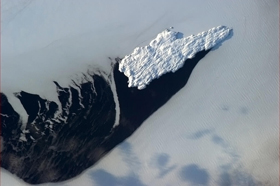
Hadfield: "Belle Isle, Newfoundland - natural icebreaker at the mouth of the Strait." April 4, 2013. (Credit: Canadian Space Agency/NASA)
-

Hadfield: "To slowly change gears from the day's amusement - something light. Right after I took this picture I ate the cookie." April 1, 2013. (Credit: Canadian Space Agency/NASA)
-
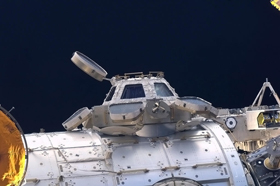
Hadfield: "The Cupola, our window on the world." April 4, 2013. (Credit: Canadian Space Agency/NASA)
-
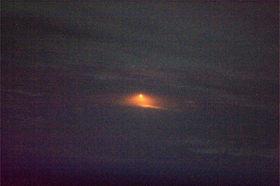
Hadfield: "Soyuz Rocket Launch - the moment of ignition, as-seen from their target, the Space Station." March 28, 2013. (Credit: Canadian Space Agency/NASA)
The crew of Expedition 35, now a robust team of six, had a busy week as new members were integrated and Station tasks assigned.
That said, Canadian Space Agency (CSA) astronaut Chris Hadfield, who celebrated his 100th day on the ISS on March 30, found time to share some Easter greetings and an April's fool joke or two.
But that did not belie the fact that the ISS Commander had a full plate of tasks to get through this week, including the removal and replacement of the Waste and Hygiene Compartment's urine hose, image transfers of Canada's BCAT-C1 colloidal experiment, and a meeting to discuss crew handover details with NASA's Chris Cassidy, which included suggestions for best on-orbit practices and lessons learned concerning ISS systems and payloads. An emergency roles and responsibilities review was also held to inform the three new crew members about what would be expected of them should an ISS emergency occur.
Perhaps Hadfield's most demanding task this week was the installation of the Ku Communications Unit 2 hardware, which will increase the number of Station downlink video channels from four to six, and the number of space-to-ground audio channels from two to four.
In outreach news, Hadfield had a successful amateur radio pass with students in Georgia as well as a video downlink event with Discovery's Daily Planet. On April 8, he will be speaking via amateur radio with the 820 Chris Hadfield Air Cadet Squadron in Milton, Ontario, and then, on April 9, with 180 students from Sir George Simpson Junior High School in Edmonton, Alberta. That same day, he will make a video appearance at the Telus World of Science – Edmonton joining over 400 students and members of the public during the CSA's first tweetup event in Western Canada in celebration of Cosmonautic Day, otherwise known as Yuri's Night.
And after an Easter weekend of chocolate and sweets, the CSA shared this timely video of Chris demonstrating how astronauts brush their teeth in space. And for those who would like to see more of Chris in action, check out how he stows a spacesuit on the ISS and how he exercises.
Find the latest news on Hadfield's mission through our Expedition 34/35 page and through our social media. Don't forget—we now have a Tumblr page to also follow.
March 22-28, 2013
-

Hadfield: "Tom, Roman and I in the mouth of the Dragon spaceship. These are two superb men to be off the Earth with." March 26, 2013. (Credit: Canadian Space Agency/NASA)
-
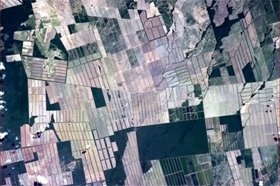
Hadfield: "Cubist farming in Brazil." March 26, 2013. (Credit: Canadian Space Agency/NASA)
-
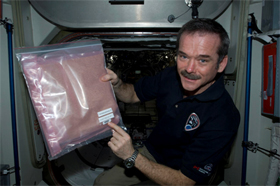
Hadfield: "600000 seeds = an infinite number of future scientists & engineers. Congrats Tomatosphere on #NSERC's Science Award!" March 26, 2013. (Credit: Canadian Space Agency/NASA)
-
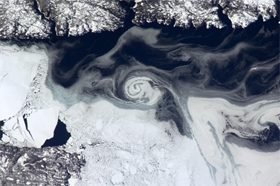
Hadfield: "A gyre frozen into the ice, Newfoundland, Canada." March 22, 2013. (Credit: Canadian Space Agency/NASA)
The ISS crew is set to double from three to six as NASA astronaut Chris Cassidy and cosmonauts Pavel Vinogradov and Alexander Misurkin make their way to Station via Soyuz spacecraft today. Commander Hadfield and crewmates have been busy the past week prepping the Station for their arrival and also for the departure of SpaceX's Dragon.
The Dragon, its belly tightly packed with science samples and hardware, was released by Canadarm2 from the Station on March 26. Its descent to Earth was a resounding success, splashing down into the Pacific Ocean at 12:32 p.m. EDT.
Hadfield, Romanenko and Marshburn participated in onboard training for an emergency response, a simulation that involved going through various locations on the ISS to practice procedures and make context-related decisions in coordination with Mission Control in Houston and Moscow.
In science, Hadfield performed an intervalometer change of the Canadian colloidal experiment BCAT-C1 and prepared the Coarsening in Solid Liquid Mixture (CSLM-3) Experiment for its 6th run. Hadfield also outfitted the MELFI freezer with ice bricks, and installed jumpers and gathered power meter measurements on the ExPRESS Logistics Carrier that hosts the Alpha Magnetic Spectrometer-02 (AMS-02).
Hadfield, continuing to reach out to the public, spoke with 570 elementary students from École des Cardinaux in Laval, Quebec through an amateur radio pass, and answered questions from Radio-Canada during a live video downlink event in French for the "24 heures en 60 minutes" and the April 7 "Découverte" shows.
Finally, Hadfield shares his workout routine with us from on board the ISS, and reveals a signature move in the process: The Hadfield Shake. Check it out on the CSA's new Tumblr channel and find out more about exercising in space on the CSA Website, where the questions most frequently asked to Hadfield on social media have also been compiled.
Next week, it's a full house on the ISS again as Expedition 35 kicks into second gear!
You can follow the latest news on our official Expedition 34/35 Mission Page and through our social media.
March 15-21, 2013
-

The Expedition 34 crew, soon after landing. From left to right: Cosmonaut Evgeny Tarelkin, Soyuz Commander Oleg Novitskiy and Expedition 34 Commander Kevin Ford. March 16, 2013. (Credit: Sergey Vigovskiy)
-
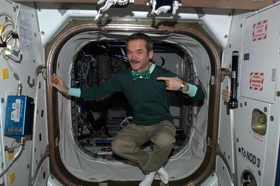
Hadfield: "Wearing the green - Happy St. Patrick's Day from the International Space Station!" March 17, 2013. (Credit: Canadian Space Agency/NASA)
-

Hadfield: "Space Pajamas: Russian-made and stylish, 2-tone blue with white socks. What all the astronauts are wearing this year." March 21, 2013.(Credit: Canadian Space Agency/NASA)
-

Hadfield: "Soyuz departing - Oleg, Kev & Evgeni passing underneath Space Station on their way home after 5 months." March 15, 2013. (Credit: Canadian Space Agency/NASA)
-
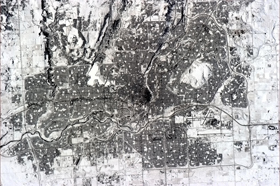
Hadfield: "Calgary in the snows of early March. Time for a warm wind from the Rockies?" March 15, 2013. (Credit: Canadian Space Agency/NASA)
Commander Chris Hadfield, Tom Marshburn and Roman Romanenko said goodbye to the crew of Expedition 34 as NASA astronaut Kevin Ford and cosmonauts Evgeny Tarelkin and Oleg Novitsky departed the Station on March 15 at 7:43 p.m. EDT. They would reach the frosty steppe of Kazakhstan at 11:06 p.m. EDT, arriving in good condition and met promptly by a recovery crew. Hadfield's Expedition 35 officially began when the hatch was shut between the Soyuz module and the Space Station.
On March 28, three new crewmembers will launch to join Hadfield and crew on board the Station: NASA astronaut Chris Cassidy and cosmonauts Pavel Vinogradov and Aleksandr Misurkin. Hadfield and Vinogradov are well-acquainted as they trained together years ago for their respective missions to the Russian Mir Space Station.
Among his many duties this week, Hadfield performed sample runs of the Canadian BCAT-C1 experiment, performed pre-pack activities for SpaceX's Dragon, reassembled and installed the Amine Swingbed Payload and, with the help of Tom Marshburn, conducted a crew health status check.
Hadfield also took part in some special events this week, chatting with Prime Minister Stephen Harper, his wife Laureen and students at the Canada Aviation and Space Museum in Ottawa, answering questions from Canadian media at CSA headquarters, and sharing a must-watch video of how spinach is prepared and eaten in weightlessness. Hadfield also released an acoustic rendition of "Danny Boy", which he recorded on the Space Station in time for St. Patrick's Day. Finally, Hadfield performed amateur radio passes with students from Australia and Austin, Texas, respectively.
Looking at the week ahead, Marshburn and Hadfield will use Canadarm2 to unberth the SpaceX's Dragon vehicle from the Station for its return to Earth on March 25. On the 26, Hadfield will speak with 570 elementary students from École des Cardinaux in Laval, Quebec via amateur radio (in French), a project initiated by grade 5 student Cédrick Côté (article in French). Hadfield can also eagerly anticipate the arrival of his aforementioned Expedition 35 crew mates when they launch on the 28.
You can follow the latest news on our official Expedition 34/35 Mission Page and through our social media.
March 8-14, 2013
-
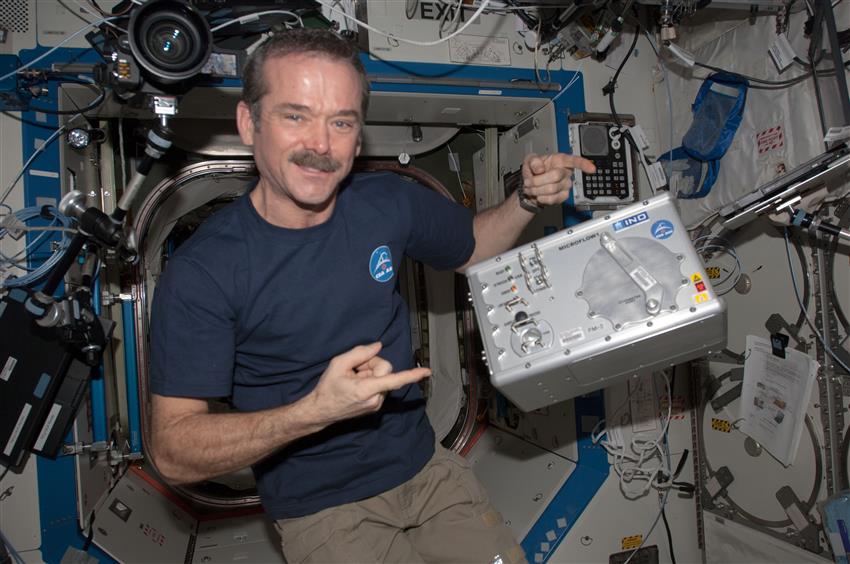
Hadfield: "Many people worked very hard to get this blood analyzer-in-a-box experiment onboard. First test - go, go Microflow!" (March 7, 2013) (Credit: Canadian Space Agency/NASA)
-

A grade 9 student at Bert Church High School in Airdrie, Alberta, asks a question to Chris Hadfield in orbit in the presence of retired Canadian Space Agency (CSA) astronaut Robert Thirsk and Bonnie Schmidt, President of Let's Talk Science. (Credit: CSA)
-

Hadfield: "Tonight's Finale: Be proud of our achievements, but don't stop there. We're heading towards the future, not the past." (March 13, 2013) (Credit: Canadian Space Agency/NASA)
-
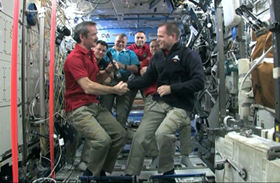
Chris Hadfield and Kevin Ford shake hands during the Transfer of Command Ceremony. (Credit: NASA)
This week history was made when Chris Hadfield became Commander of the International Space Station during the Transfer of Command ceremony. Hadfield is the first Canadian to receive this title, and was honoured with the Canadian anthem and a handshake from Expedition 34 Commander Kevin Ford.
Hadfield is commanding Expedition 35 and chief among his new duties will be responsibility for any final decisions required in an emergency event. His role as Commander will end mid-May, when he and the other members of Expedition 35 return to Earth.
Hadfield received congratulations from around the world, notably from Her Majesty The Queen of England and the Prime Minister of Canada, Stephen Harper.
Prior to becoming Commander, the Canadian Space Agency released this video message of Hadfield reflecting on his life and that imparts advice on how a person can mould themselves into the individual they wish to be.
Earlier in the week, Hadfield took part in a live video discussion with 1000 students from Bert Church High School in Airdrie, Alberta. BCHS grade 9 students are participating in Let's Talk Science's CurioCity Radi-N2 & You Action Project that was developed to engage Canadian classrooms in an experiment similar to Hadfield's Radi-N2. Retired CSA astronaut Robert Thirsk was also on-hand to answer questions from the eager group. Hadfield also had a successful amateur radio pass with students from Martensville, Saskatchewan.
The Canadian Space Agency also released a video in which Hadfield describes how a person's sense of taste changes in weightlessness and shares a collection of Canadian food brought to the Station on board SpaceX's Dragon. Hadfield also filmed a recent haircut in the weightless environment of the ISS: International Space "Salon".
In terms of Canadian science, Hadfield performed a run of the experiment Microflow, which analyzes blood and fluid samples to monitor physiological and cellular activity. Hadfield also performed a retrieval and readout of neutron radiation for Radi-N2, and on March 7 performed a sample run on the Canadian colloidal experiment BCAT-C1.
The crew of Expedition 34 is scheduled to return to Earth on March 14, with Expedition 36 joining them on the ISS later in March. Next week, Hadfield will continue to help pack SpaceX's Dragon among a slew of science and maintenance activities for the new Station Commander.
You can follow the latest news on our official Expedition 34/35 Mission Page and through our social media.
February 28-March 7, 2013
-

Hadfield: "Tonight's Finale: A Dragon, snared and tamed by Canadarm2. Saint George ringing in a new era in the silence of space." March 3, 2013 (Credit: Canadian Space Agency/NASA)
-

Hadfield: "Happy crewmember - Dragon securely snared by Canadarm2, ready to be lifted around, hooked into place, and opened up." March 3, 2013 (Credit: Canadian Space Agency/NASA)
-
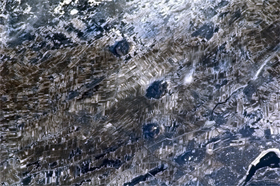
Hadfield: "Ancient mountain roots stand out roundly amongst the patchwork fields in this Quebec winter landscape." March 5, 2013 (Credit: Canadian Space Agency/NASA)
-
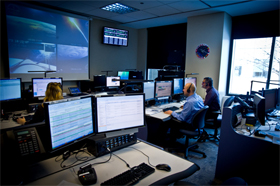
A team of the Canadian Space Agency (CSA) scientists and engineers provide support from the Payload Telescience Operations Centre (PTOC) whenever Canadian science experiments are performed aboard the ISS. March 5, 2013 (Credit: CSA)
This past week was a particularly busy and successful one for Canadian robotics and science. March 3 saw the capture and "taming" of SpaceX's Dragon by Canadarm2. Dragon, launched March 2, had technical issues related to its thrusters, delaying its approach to the Space Station. However, the Dragon did eventually spread its wings (in this case, solar arrays) to rendezvous with the Station, and was plucked from its orbit by Canadarm2 early Sunday morning at 5:31 a.m.
The Dragon's contents were quickly scooped out of its belly, which included fresh food and Canadian snacks, and the Canadian science instrument Microflow, a break-through toaster-size device that can perform blood sample analysis.
The capture was likely an emotional one for Chris Hadfield, who attached Canadarm2 to the Space Station in 2001. He expresses his sentiment about the arm and gives a tour of the Robotics Workstation in this video.
On March 6, Canadian science grabbed the spotlight as both Radi-N2 and BCAT-C1 were performed in-Station with support from CSA scientists and engineers on the ground. Chris Hadfield initiated the fourth and final session of Radi-N2 for this increment, activating two neutron bubble detectors, one that he appended to himself and the other he placed in his sleeping quarters. Results will be available for the Let's Talk Science project, which is comparing radiation levels on the Space Station with radiation levels that students are recording on Earth. Hadfield will talk with 1000 grade 9-12 students from Airdie, Alberta involved with this project via a live video stream on March 11.
Hadfield also activated Microflow for the first time, successfully completing two sample runs.
As well as performing his usual array of science and maintenance activities, Hadfield found time to chat with students in Charlottetown P.E.I via amateur radio and also with students from California in this NASA video downlink.
Hadfield also shared this insight into how astronauts clean up spills in zero-g.
And little known until now, Hadfield has added a new task to his already long list of duties: your tax return, in space! Check out this Rick Mercer clip for the full story.
On March 13, Chris Hadfield will make history when he officially becomes the first Canadian Commander of the International Space Station. Live video of the Change of Command ceremony, scheduled for 17:10 EDT (subject to change) will be available on NASA TV and the CSA Webcast website.
You can follow the latest news on our official Expedition 34/35 Mission Page and through our social media.
February 23-28, 2013
-
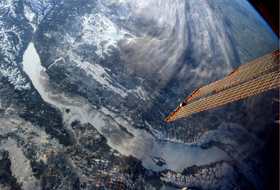
Hadfield: "Tonight's Finale: Lake Baikal, Siberia. Immensely old and deep, it holds one-fifth of all the Earth's fresh water." February 26, 2013. (Credit: Canadian Space Agency/NASA)
-
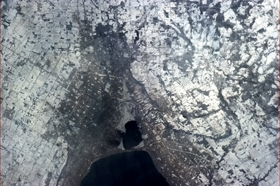
Hadfield: "Hamilton, at the tip of Lake Ontario. Steel town, with the Niagara Escarpment just visible from space." February 23, 2013. (Credit: Canadian Space Agency/NASA)
-

Hadfield: "Weightless in my new space pajamas - made in Russia, very warm and comfy." February 26, 2013. (Credit: NASA)
-

Hadfield snapped this shot of Canadarm2, which will be used to capture Space X's Dragon. February 25, 2013. (Credit: Canadian Space Agency/NASA)
A dragon looms, and the crewmembers of Expedition 34 are preparing for its capture. This Friday, the SpaceX Dragon cargo vehicle will launch from Cape Canaveral, Florida at 10:10 a.m. EST to rendezvous with the International Space Station (ISS) the following day. The crew will use Canadarm2 to reach out and grab the approaching ship. Prior to capture they've been preparing items to be stowed on the Dragon after it is unloaded.
For his part this week, Hadfield performed an install and checkout of the Centerline Berthing Camera System, which will be used for the capture and mating of the Dragon to the space station.
Hadfield was active with science experiments, initializing runs of the Canadian BCAT-C1, setting up the hardware for a particle experiment called Coarsening in Solid-Liquid Mixture, performing his fourth and final session of the Reversible Figures Experiment and inspecting and cleaning the Microgravity Science Glovebox. Hadfield also managed some interesting maintenance tasks, including testing the air for microbes and removing and replacing a Urine Processing Assembly recycling tank.
On Wednesday, the crew were subjected to the blare of a fire alarm in the US Destiny Lab, but after Hadfield inspected the facility, it proved to be a false alarm. The Expedition 34/35 crew also took part in an emergency egress drill in the Soyuz TMA-07M.
Earlier in the week, Hadfield joined Kevin Ford and Tom Marshburn for NASA's first ever Google+ Hangout from space. Hadfield and Marshburn also took part in a video downlink with students gathered at the Metropolitan Arts Institute in Phoenix for Destination Station, and Hadfield reached out to 450 students in Pentincton, BC and a group of third-graders in California through the ARISS amateur radio program.
To watch the crewmembers catch a Dragon on Saturday, tune in to NASA Television or the CSA Webcast Website. The capture is currently planned for 6:20 a.m. EST. Exact time is subject to change.
On March 5, it will be Canadian Science on the ISS day, as three out of a possible five Canadian science experiments will be conducted on Station by Chris Hadfield, including BCAT-C1, Radi-N2, and the toaster-sized Microflow, which can analyse and diagnose blood samples in a matter of minutes.
You can follow the latest news on our official Expedition 34/35 Mission Page and through our social media.
February 16-22, 2013
-
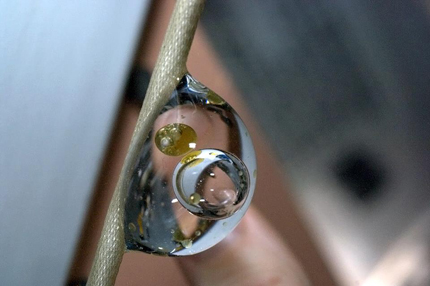
Hadfield: "Weightless liquids behave oddly--an air bubble and pepper oil jockey for position in a ball of water." February 19, 2013. (Credit: Canadian Space Agency/NASA)
-

Hadfield: "The grappling mechanism at the tip of Canadarm2. The cables snare a shaft and pull in, the teeth lock it in place." February 17, 2013. (Credit: Canadian Space Agency/NASA)
-

Hadfield: "Mixing colloids in a test tube, then watching them form structures. Space science!" February 20, 2013. (Credit: Canadian Space Agency/NASA)
-
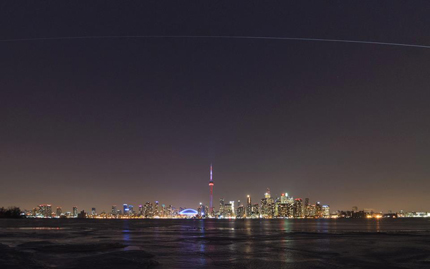
Hadfield: "Space Station over Toronto, lovely time lapse photo taken by friend Andrew Yee on 13 Feb. — with CN Tower." Photo released February 19, 2013. (Credit: Andrew Yee)
On February 15, Chris Hadfield took part in a live space to Earth connection with some 500 students from the University of Waterloo in the company of CSA astronaut Jeremy Hansen and Dr. Hughson, the Principal Investigator for two of the five Canadian experiments currently aboard the ISS. On the 17th, Hadfield continued to reach out to the public and the Reddit community, taking part in his third Ask Me Anything (AMA) and his first from space. The AMA generated over 2,000 comments and questions, and elicited several insightful comments from Hadfield. You can read the entire AMA or read five of his best as deemed by Forbes.
The next day, Hadfield performed two Canadian science experiments. He did a retrieval and readout of neutron bubble detectors for Radi-N2 and an intervalometer change for the colloidal experiment BCAT-C1.
Hadfield also created a lot of buzz on the internet with the CSA's Chris Hadfield's Space Kitchen, a video with a Julia Childs flavour in which Hadfield shows us how to make a sandwich... in space!
On the 19th, the ISS upgraded the software on its computers, causing an unexpected loss of communication with the ground team. This lasted for a few hours in the morning, but was re-established for good by 12:34 p.m. EST.
On the 20th, Hadfield was busy with maintenance duties, changing out a belt and removing life support modules in the Columbus Laboratory's Biolab, doing a pre-pack for the upcoming arrival of the Dragon commercial resupply vehicle, as well as other tasks.
Hadfield also took part with his crew mates, NASA astronauts Kevin Ford and Tom Marshburn, in a NASA Social event entitled Science on the International Space Station – Gateway to the Universe. In these videos, Hadfield comments on how bodies adapt to weightlessness and how math is used in space.
On the 22nd, Hadfield will take part in a NASA Google+ Hangout, perform more BCAT-C1 activities and do an amateur radio pass with Penticton, BC students.
Next week, the crew prepare for the arrival of SpaceX's Dragon, which will be captured by Canadarm2.
You can follow the latest news on our official Expedition 34/35 Mission Page and through our social media.
February 9-15, 2013
-
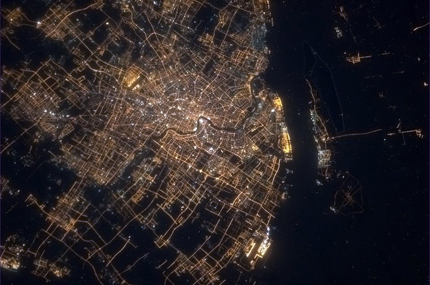
Hadfield: "Shanghai, China. Home to more than 23 million people. Vibrant, cosmopolitan port at the mouth of the Yangtze River." February 9, 2013. (Credit: Canadian Space Agency/NASA)
-
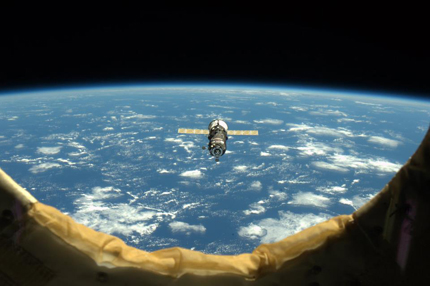
Hadfield: "Progress spaceship on final approach to dock. You could see the thrusters firing, like small spitting fountains." February 11, 2013. (Credit: Canadian Space Agency/NASA)
-
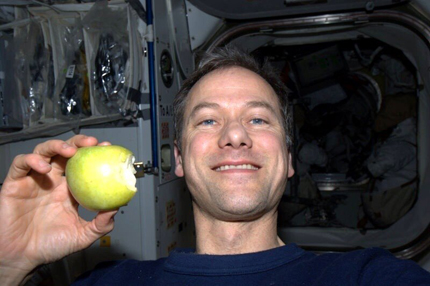
Tom Marshburn (@AstroMarshburn): "Fresh apples from Kazakhstan! Opened the Progress hatch this morning. What a treat!" February 12, 2013. (Credit: Tom Marshburn/NASA)
-

Hadfield: "A weightless waffle with Canadian maple syrup floats out of its package on Station for Shrove Tuesday. Very tasty!" February 12, 2013. (Credit: Canadian Space Agency/NASA)
This week, the crew of Expedition 34 said goodbye to one Progress vehicle and welcomed the arrival of another.
Regarding the former, which made its way to the Earth's atmosphere from the International Space Station (ISS) on the 9th, Hadfield tweeted: "Happy Chinese New Year! May it be filled with joy and success. To celebrate, we sent a Progress spaceship to burn like fireworks in the sky."
Hadfield followed up on the advent of the Year of the Snake by taking a series of pictures of China at night, including a couple of shots of its mysterious neighbor, North Korea.
On the 11th, the unpiloted Progress 50 cargo ship docked to the ISS, bringing with it fresh food and supplies.
Hadfield was busy on that day initializing another round of the Canadian experiment Radi-N2 – the experiment Let's Talk Science is replicating – and doing a run of InSPACE-3, as well as performing a SLAMMD session to measure his body mass to support a nutrition experiment.
The following day, Hadfield set up a new sample for the Canadian colloidal experiment BCAT-C1.
Throughout the week Hadfield and the Expedition 34 crew were preparing items to be packed into SpaceX's Dragon when it arrives in early March.
The crew also had a training session for the capture and docking of the Dragon, which will be grappled by Canadarm2 when it approaches the ISS.
As part of the Amateur Radio on the International Space Station (ARISS) program, Hadfield spoke to students from Chief Peguis Jr. High in Winnipeg on the 13th via HAM radio.
On Valentine's Day, in celebration of heart health month, the CSA released a video in which Hadfield speaks about cardiovascular research on the ISS.
In keeping with the heart theme, he will be part of a live video event on the 15th with some 700 students of the University of Waterloo. U of W's own Dr. Richard Hughson will also be on hand to give an overview of ISS experiments he is the lead researcher on, including BP Reg and Vascular, which both concern the effects of weightlessness on the cardiovascular system.
You can follow the latest news on our official Expedition 34/35 Mission Page and through our social media.
February 1-8, 2013
-

The Canadian tweetup watched around the twitterverse. Chris Hadfield speaks with William Shatner from Space to Earth, streamed live at the CSA headquarters in Longueuil, QC. February 7, 2013. (Credit: Canadian Space Agency)
-

Hadfield, via Twitter: "The startling verdant green of this swamp in Paraguay caught my eye from my perch a million feet up." February 6, 2013. (Credit: Canadian Space Agency/NASA)
-

Hadfield, via Twitter: "Proud installer of ultrasonic sensors to detect leaks in a space ship. Good to have." February 6, 2013. (Credit: Canadian Space Agency/NASA)
-

On February 8, the official song of Music Monday 2013 was released. (Credit: CBC Music)
Science fact and science fiction converged this week as, after marking a new Space Station record, Chris Hadfield opened a hailing frequency to fellow Canadian and former starship captain, William Shatner. Following up on their tweets that shook the twitterverse, the two conversed for about ten minutes via a space-to-Earth linkup that was recorded and streamed on the CSA website. About 30 "space tweeps" attended in person, some having the opportunity to ask Hadfield questions. The Canadian Principal Investigators with experiments aboard the Space Station gave presentations as well. CSA astronaut Jeremy Hansen served as host. A video of this distinctly 21st century event and the highlights of the Hadfield/Shatner conversation can be viewed on our YouTube Channel.
As notable as the CSA Tweetup was, it was certainly made sweeter by the tremendous achievement the Expedition 34 crew made the week prior when they performed 71 hours of science and research on the Station, breaking a previous record by four hours. This was a feat that not only the astronauts on board could take pride in, but also the ground support and ISS payloads groups, which include employees of the CSA.
Concerning the aforementioned science performed on the Station, Hadfield was busy photographing colloid samples for the Canadian BCAT-C1 experiment. He also did several runs of another colloid experiment, InSPACE3, a Neurospat session, and conducted Biolab Life Support System maintenance and troubleshooting, among other science and technology related duties.
Hadfield also began a JAXA (Japan Aerospace Exploration Agency) education payload called Blue Earth Gazing, which involves seeing and filming the Earth as a reflected image on the surface of the water!
Speaking of the Earth, one of the few men who have looked upon it as if it were no bigger than a blue and white marble - Apollo 17 astronaut Gene Cernan - spoke to Hadfield and the Expedition 34 crew from Mission Control Houston. A couple weeks before launching Hadfield made this video tribute to Cernan and his crew mates.
Next week, Hadfield performs more BCAT-C1 activities and will take part in a special joint CSA/University of Waterloo event with Canadian researcher Richard Hughson, who is studying the effects of weightlessness on the cardiovascular system with the Vascular and BP Reg experiments. There will also be more sessions of the Canadian Radi-N2 experiment, which monitors neutron radiation levels on the ISS.
And on Friday, the highly anticipated I.S.S. (Is Someone Singing) song, co-written by Hadfield and Barenaked Ladies frontman Ed Robertson, was released as part of a partnership with Music Monday, CBC Music and the Canadian Space Agency. The song explores what it's like to look down on the Earth from outer space. It will also be the official song for the 2013 edition of Music Monday, which takes place on May 6. Watch the video!
Also on Friday, Hadfield spoke via amateur radio with young patients of SickKids Toronto. His next session will be with the Chief Peguis Jr. High in Winnipeg, Manitoba on Wednesday, February 13.
You can follow the latest news on our official Expedition 34/35 Mission Page and through our social media.
January 25-31, 2013
-
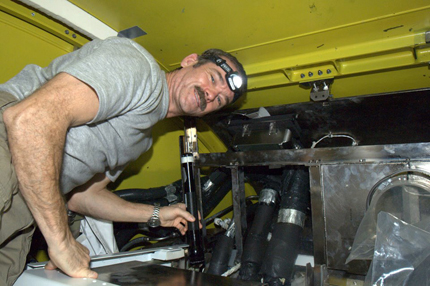
Hadfield on Twitter: "Replacing cooling lines for the spacewalk suits. Thick black insulation keeps dew from forming and causing corrosion." January 25, 2013. (Credit: Canadian Space Agency/NASA)
-
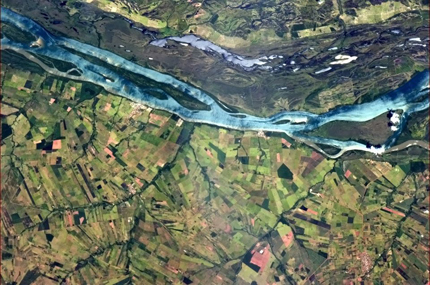
Hadfield on Twitter: "A blue river in Brazilian farmland provides a striking contrast of colour and landscape." January 29, 2013. (Credit: Canadian Space Agency/NASA)
-
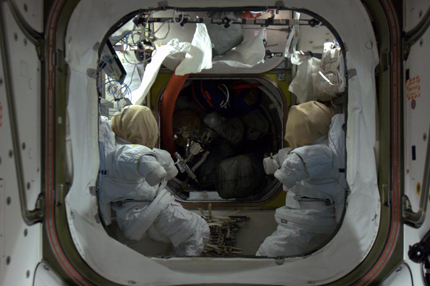
Hadfield on Twitter: "Two spacesuits locked in an eternal staring contest, ready to take us outside if needed." January 28, 2013. (Credit: Canadian Space Agency/NASA)
-
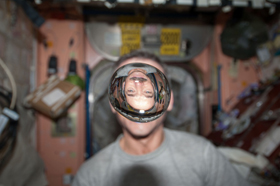
Hadfield on Twitter: "Weightless water. This picture is fun no matter what direction you spin it." January 27, 2013. (Credit: Canadian Space Agency/NASA)
While Chris Hadfield was completing activities such as an intervalometer change of the Canadian colloid experiment BCAT-C1, as well as doing three more runs of the InSPACE-3 experiment, Canadarm2 and Dextre were being operated from the ground to perform several tasks on the International Space Station (ISS). Much of the activity involved transferring containers, equipment and items like the On-orbit Replacement Units (ORU) to various parts of the exterior of the Station.
On Wednesday night the crew were woken up by the bleating of a fire alarm installed on the Russian Zarya module of the Station. Fortunately, there was no fire. Upon further inspection, the smoke detector proved to be faulty and was deactivated for future repairs.
The interruption to his sleep seemed to have no effect on Hadfield as later in the day he spoke with His Excellency the Right Honourable David Johnston, Governor General of Canada, and some 250 grade 5-6 students from the National Capital Region gathered at the Canada Aviation and Space Museum via a live video link. To answer the students' questions, Hadfield performed several demonstrations of activities in space, including sneezing and how astronauts wash their hands.
Among other notable tasks this week, Hadfield activated the EarthKAM (for Earth Knowledge Acquired by Middle School Students) software for a week-long imaging session, gathered items for the upcoming Dragon Transfer Preparations, activated and deactivated the Microgravity Science Glovebox, and inspected six oil dispensers for the PACE colloid experiment.
As well as taking a slew of breathtaking images from space, a few of Hadfield's videos were edited and posted online, including the viral video Mixed Nuts in Space (which has nearly two million views!); a video of Hadfield storing biological samples that could help researchers learn more about osteoporosis, and a clip where the soon-to-be Station commander explains how astronauts wash their hands in zero-g.
Next week, Hadfield will perform some runs of BCAT-C1 and on February 7, will have a "day in the life" video downlink with some eager space tweeps and a very special guest.
You can follow the latest news on our official Expedition 34/35 Mission Page and through our social media.
January 18-24, 2013
-
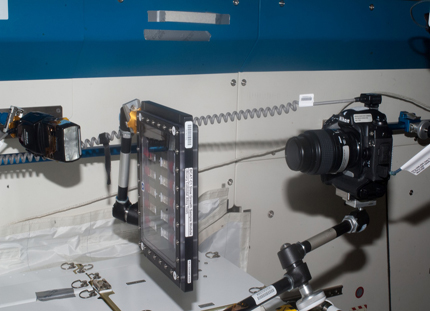
The BCAT-C1 hardware set up in the Japanese Kibo laboratory. January 21, 2013. (Credit: NASA)
-

A view of Toronto from space taken by Hadfield on the first night of the 2013 NHL season. January 19, 2013. (Credit: Canadian Space Agency/NASA)
-

Hadfield drops the puck from the ISS during the Maple Leafs home opener on January 19, 2013. (Credit: Canadian Space Agency/NASA/Maple Leafs)
-

Hadfield points to a neutron bubble detector he deployed on the ISS on January 18, 2013. (Credit: NASA)
The week started with CSA astronaut Chris Hadfield deploying two of four neutron radiation detectors for the Canadian experiment Radi-N2. One of the detectors was placed in his sleeping quarters and the other he is wearing. Radi-N2 will continue throughout the weeks ahead and is the subject of the Let's Talk Science initiative that invites classrooms to learn more about radiation by following the experiment and monitoring their own radiation exposure on the ground.
Also in Canadian science, BCAT-C1 was set up in the Japanese Kibo module of the International Space Station (ISS) on January 21 by current Station Commander Kevin Ford. The first run of the experiment was on the 23rd, and will continue throughout next week. You can watch Hadfield describe BCAT-C1 in this video.
Hadfield also took part in NASA science and medical operations. He had a spinal ultrasound scan to monitor changes to his spine, and he had a retinal scan as part of the Panoptic Eye Exam. He also helped in taking spinal and retinal scans of his NASA crew mates.
As any Canadian knows, hockey resumed this week, and Hadfield performed the puck drop in the home opener of the Toronto Maple Leafs vs Buffalo Sabres game. As a proud member of "Leafs Nation," Hadfield "dropped" the puck from the ISS, which was then caught by ex-Leafs goalie Felix Potvin. You can watch how it all unfolded.
As well as the usual biological samples that Hadfield needs to take and store, he also had a full task list of maintenance work, including plumbing. Working in the European Columbus module, he replaced an on/off valve with help from Kevin Ford and ground controllers in Germany. He also moved a science rack inside Columbus, and on the 22nd and 23rd, spent several hours replacing the spacesuit heat exchanger hardware in the Quest airlock.
Hadfield and crew were not the only ones busy this week as the Robotics Refueling Mission (RRM) was carried out. The Canadian robot Dextre performed wire cutting operations on the Safety Cap wire and Actuation Nut, stowed the Wire Cutting Tool, and mated the Tool Changeout Mechanism to the Safety Cap Tool connector. All is going well as RRM demonstrates how satellites can be serviced using robotics technology.
Coming up, Hadfield will speak with a few lucky Twitter followers during a special tweetup event on February 7 at the Canadian Space Agency that will give insight into a day in the life of an astronaut on the International Space Station. He will also take part in BCAT-C1 operations and as always, will continue to awe with his astro-eye's-view of Earth from space.
You can follow the latest news on our official Expedition 34/35 Mission Page and through our social media.
January 11-17, 2013
-

Hadfield in the cupola at the helm of the Canadarm2 for the first time. (Credit: NASA)
-

Hadfield speaks to the students of the Chris Hadfield Public School. (Credit: Canadian Space Agency)
-
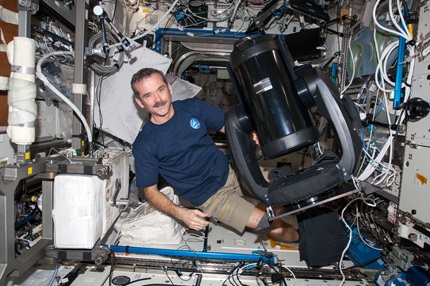
Hadfield with the ISERV telescope he installed. (Credit: NASA)
-

Hadfield: The Earth's horizon, just before sunrise. Beautiful lines of colour, a rainbow halo for the planet. (Credit: Canadian Space Agency/NASA)
Right before a spirited live downlink event from the Space Station with Canadian media on January 10, CSA astronaut Chris Hadfield took to the controls of Canadarm2, over eleven years after he performed the first Canadian spacewalk to install it. Hadfield was sharpening his skills for robotics operations he will perform later in his mission to grab the SpaceX Dragon resupply vehicle.
Later in the week he also installed the ISERV telescope. ISERV is an automated system that will collect images of the Earth's surface from the ISS. It will be particularly helpful in monitoring and assessing environmental disasters.
On the 14th, while Hadfield was powering up the InSPACE-3 hardware inside the Microgravity Science Glovebox, ground controllers in Canada and Houston were gearing up for a week's worth of Robotics Refueling Mission (RRM) activities. RRM uses Canadarm2 and Dextre, the Canadian space robotics handyman, to uncap and refuel a satellite mock-up. Operations extend from the 14th to the 23rd.
Also during the 14th, the crew performed an emergency escape drill, seeking refuge in the Soyuz vehicles they arrived in. The simulation covers such scenarios as a fire, a pressure leak or a toxic chemical release.
Hadfield performed several maintenance tasks throughout the week, including rewiring the US Destiny lab and changing out the toilet's solids tanks.
The Commander-to-be was also busy capturing his incredible experience through photos and videos, taking breathtaking shots of our planet and sharing a video about the not-so-mundane experience of clipping his nails in space.
Hadfield had two successful HAM radio sessions during the week, the first with 275 Royal Canadian Air Cadets of St. John's, Newfoundland on January 12. The second contact took place just this morning with 400 students of Saint Rose Elementary School in Saint John, New Brunswick. These exchanges were arranged through the Amateur Radio on the International Space Station (ARISS) program.
Today, he also took part in a downlink Q&A event with the 800 students of the Chris Hadfield Public School in his hometown of Milton, Ontario. The event was hosted by fellow Canadian astronaut Jeremy Hansen. Next week on the 21st, he is scheduled to begin the Canadian colloidal experiment BCAT-C1.
Tomorrow, Hadfield will deploy the Canadian-made Radi-N2 radiation bubble detectors for the second time since his arrival in orbit. The deployment coincides with the deadline for Canadian classrooms to register in the Let's Talk Science Radi-N2 & You CurioCity Youth Action Project, an opportunity to replicate the experiment in high schools and learn about the hazards of radiation in space and how that radiation affects us on Earth. Next week on the 21st, Hadfield is also scheduled to begin the Canadian colloidal experiment BCAT-C1.
As one of the reciprocal effects of his social media efforts, Hadfield is leading the pack for the Science category in the Shorty Awards for Excellence in Social Media.
You can follow the latest mission news on our official Expedition 34/35 Mission Page and through our social media.
January 4-10, 2013
-

Hadfield storing biological samples in the Minus Eighty Degree Laboratory Freezer for ISS (MELFI). (Credit: Canadian Space Agency/NASA)
-
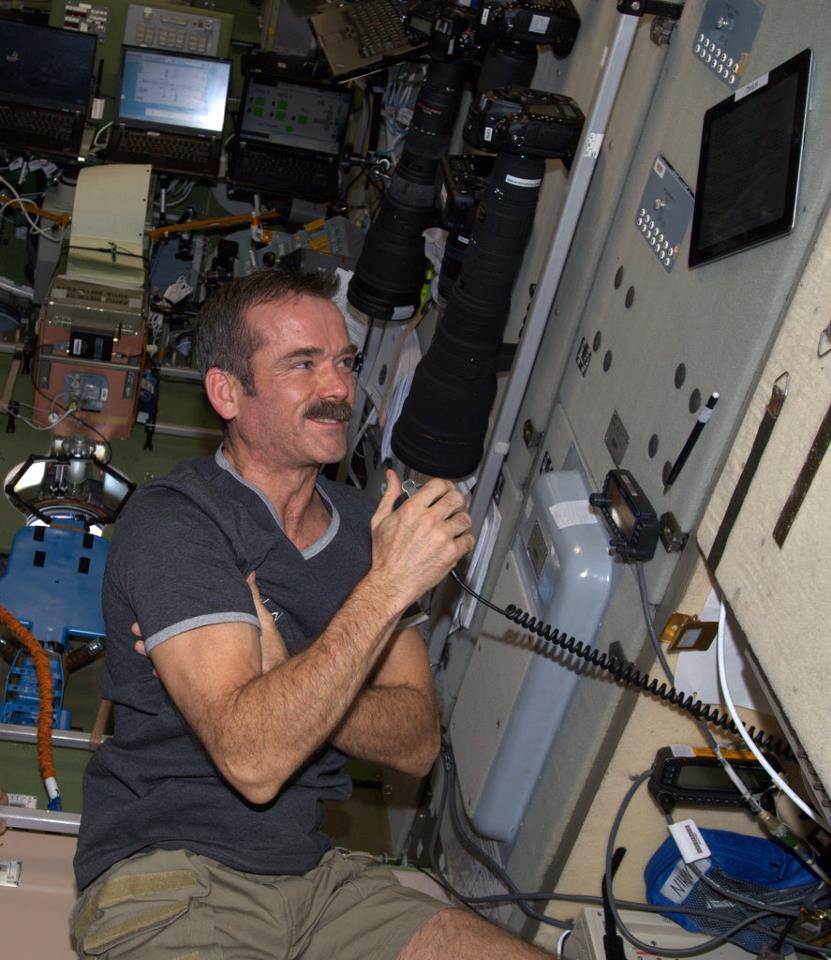
Hadfield during his HAM Radio session with the students of Charles P. Allen High School in Bedford, Nova Scotia. (Credit: Canadian Space Agency/NASA)
-
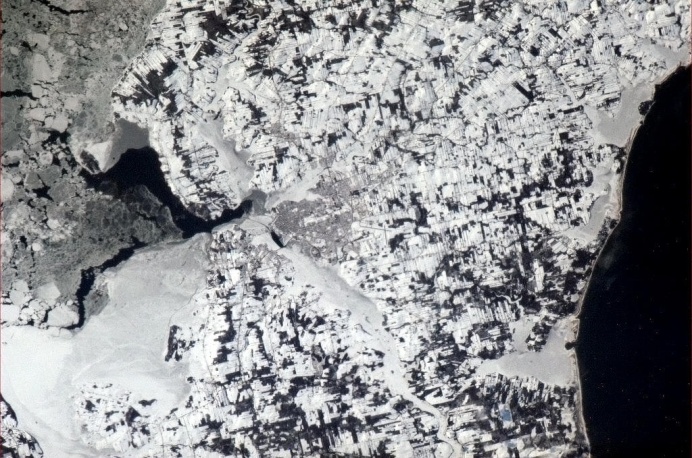
Via Twitter on January 10 - Charlottetown, PEI. The birthplace of Canada's Confederation, seen from orbit by a Canadian, 146 years later. (Credit: Canadian Space Agency/NASA)
-

Hadfield exercising on the Cycle Ergometer with Vibration Isolation System (CEVIS) on the International Space Station. (Credit: NASA)
Earlier in the week Chris Hadfield exchanged a series of tweets that many in cyberspace have lauded as Twitter's greatest meme. Responding to William Shatner's (Star Trek's Captain Kirk) query if he was really tweeting from space, Hadfield replied, "Yes, Standard Orbit, Captain. And we're detecting signs of life on the surface." This touched off a series of social media exchanges from Leonard Nimoy (Spock), George Takei (Mr. Sulu), Wil Wheaton (Wesley Crusher) and Buzz Aldrin! The conversation was picked-up by print and electronic media throughout the world.
Hadfield also continued to awe the public and media alike with his Earth from space photos, which have been gathered into galleries on his Facebook page. Compelling photos include snow-swept Canadian cities, a diamond ring-like Italian coast, and the recent Australian bushfires.
Of course there's a lot of work to be done on the Space Station, and not all of it glamorous. Along with Commander Kevin Ford, Hadfield assumed the role of space plumber, overhauling the Waste and Hygiene Compartment—the space toilet, which involved taking apart, inspecting and cleaning its parts.
Hadfield also participated in several biomedical experiments and fitness evaluations, collecting blood and urine samples and storing them in the Minus Eighty Degree Laboratory Freezer for ISS (MELFI) for later analysis on Earth.
The work week was shortened somewhat as the crew celebrated Russian Orthodox Christmas, but Hadfield still managed to do some science, including the deployment of MARES and sessions of the colloid experiment InSPACE3 and the Reversible Figures Experiment (perception of objects). In terms of Canadian science, Hadfield will deploy the Radi-N2 radiation bubble detectors for a second time from January 18-25 and a first run of BCAT-C1 is scheduled to take place on January 21.
Hadfield had his first HAM Radio session this week, speaking to the Charles P. Allen High School in Bedford, Nova Scotia. His next session will be with air cadets from Newfoundland on January 12, 9:40 a.m. EST/14:40 UCT using the NA1SS and VO1BZM call signs (date and time are subject to change).
On the 10th, Hadfield operated Canadarm2 for the first time since he installed it in 2001 during the historic STS-100 Mission. He's priming his skills for a future capture of SpaceX's Dragon vehicle and at the same time preparing the robotic arm for the Robotic Refueling Mission operations scheduled next week. Fellow Canadian astronauts Jeremy Hansen and David Saint-Jacques assisted as CAPCOMs, rounding out a truly Canadian day.
Maintaining the theme of the day, Hadfield had his first Canadian press conference from orbit, speaking to media from the CSA's headquarters in Longueuil, Quebec. Video highlights will appear on our website and YouTube channel.
You can follow the latest mission news on our official Expedition 34/35 Mission Page and through our social media.
December 21, 2012 - January 3, 2013
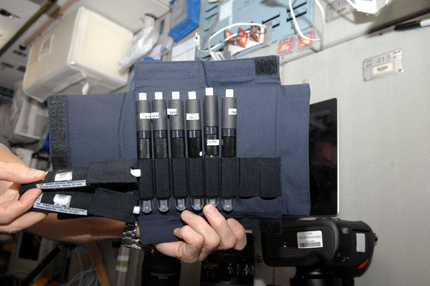
Unpacking Radi-N2's neutron bubble detectors. (Credit: NASA)

Running on the COLBERT treadmill. (Credit: Canadian Space Agency)
After docking to the International Space Station (ISS) at 9:09 a.m. and opening the hatch at 11:37 a.m. on December 21, 2012, CSA astronaut Chris Hadfield and the crew of Expedition 34/35 unpacked and got reacquainted to life on board the ISS. During this time Chris had the opportunity to record an original song called Jewel in the Night, which he downlinked and made available on the 24th. He also recorded various sounds from around the ISS for the curious, including its ambient noise.
After a Christmas celebration filled with carolling, the crew got down to a more intense work schedule. Hadfield performed a number of experiments through the week, including the Reversible Figures Experiment, Neurospat and the deployment of a number of neutron radiation monitoring bubble detectors for the Canadian experiment Radi-N2.
Hadfield also underwent various training and exercise sessions, cycling on CEVIS and running on the treadmill known as the COLBERT.
For New Years, the crew sent a special video greeting to Earth.
Throughout his stay Hadfield has been communicating with the public through Twitter and posted a series of stunning views of the Earth from space. A gallery of the Canadian sites can be viewed on the Canadian Space Agency Facebook page.
Today, Hadfield retrieved and took readouts from the Radi-N2 bubble detectors.
You can follow the latest mission news on our official Expedition 34/35 Mission Page and through our social media.
December 21, 2012

December 21, 2012 - Chris Hadfield and his crewmates at the International Space Station (Credit: NASA TV)
The Soyuz TMA-07M, transporting Chris Hadfield and his crewmates docked with the International Space Station at 9:09 a.m. EST this morning. They opened the hatch to their new orbital home, where Kevin Ford, Oleg Novitskiy and Evgeny Tarelkin, at 11:37 a.m.
Please note that our blog will not be published in the next two weeks. Visit the CSA Website and social media accounts for updates.
Happy Holidays!
The Communications Mission Team
December 14-20, 2012

December 19, 2012 – One last kiss - Chris and his wife Helene Hadfield, the morning before launch. (Credit: Robin Hadfield)
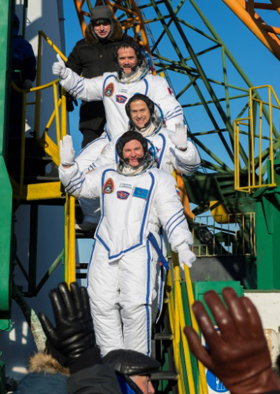
December 19, 2012 – The Expedition 34/35 wave goodbye to the crowd just before they board the Soyuz rocket. (Credit: NASA/Carla Cioffi)
After two years of rigorous training and a lifetime of preparation, Chris Hadfield launched yesterday at 7:12 a.m. aboard a Soyuz rocket en route to the International Space Station (ISS). It was a clean, picture-perfect lift off for the crew of Expedition 34/35 who will rendezvous with the Station at 9:12 a.m. on Friday.
Hadfield, set to make history by being the first Canadian Commander of the ISS during Expedition 35, spent the week prior to launch in quarantine. During this time he toured Baikonur - visiting the Korolev Museum - spoke to media, and said his goodbyes to family and friends.
While Chris orbits the Earth in the Soyuz, his son Evan is commandeering his Twitter account, and also wrote this thoughtful piece on life as an astronaut's son.
The launch was televised at CSA headquarters and featured appearances and insights from the Right Honourable David Johnston, Governor General of Canada, CSA President Steve MacLean, retired CSA astronaut Robert Thirsk and current CSA astronaut David Saint-Jacques. Lift off was met with cheers and applause from the CSA crowd, who are more than a little proud of their astronaut. Video of the event
You can follow the latest mission news on our official Expedition 34/35 Mission Page and through our social media.
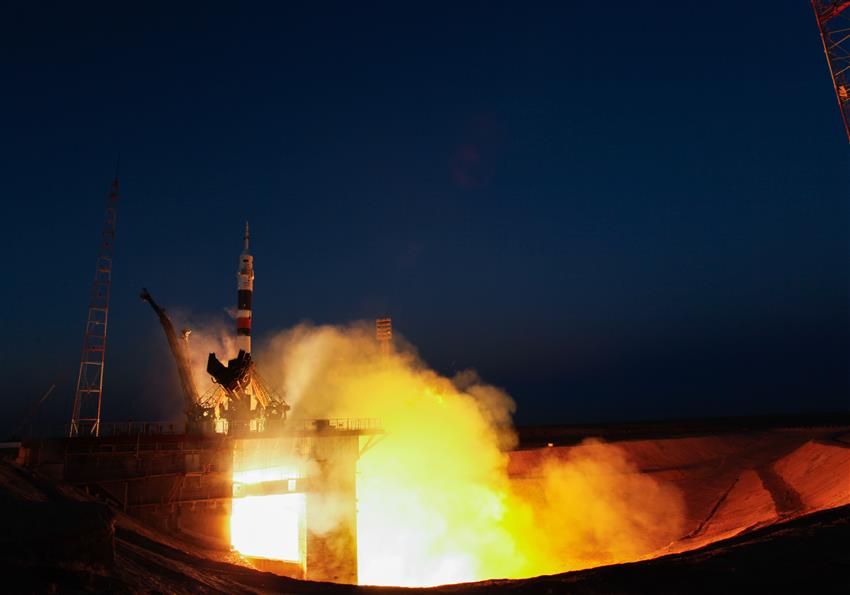
December 19, 2012 – The Soyuz TMA-07M at the start of launch. (Credit: NASA/Carla Cioffi)
December 7-13, 2012

December 7, 2012 - CSA astronaut Chris Hadfield and crew mates perform a fit-check in the Soyuz module that will take them to space. (Credit: Victor Zelentsov)

December 9, 2012 - CSA astronaut Chris Hadfield hoists the Canadian flag up during the Baikonur flag-raising ceremony. (Credit: Victor Zelentsov)
Early in the week, the Expedition 34/35 crew took part in a flag raising ceremony in Baikonur, Kazakhstan, just outside the Cosmonaut Hotel. Chris Hadfield proudly hoisted the Canadian flag for his country. The crew also took part in what is called a fit-check, getting suited up and seated in the Soyuz that they will travel in, the TMA-07M. The dress-rehearsal for the big day went off without a hitch.
Now in quarantine at the Baikonur Cosmodrome, the crew are using their time to make final preparations, exercise, relax and talk to media by phone and internet. In fact, today at 11 a.m. EST Hadfield will reach out directly to the public, doing an AMA (Ask Me Anything) on Reddit.
With less than a week before launch, Hadfield has expressed both his excitement and eagerness to put two years of mission-specific training - and a lifetime of commitment - to use as the Commander of the International Space Station. He will continue to relate his experiences as an astronaut throughout the mission via his Twitter feed and Facebook page.
The Soyuz TMA-07M will be transported by railcar to the Baikonur launch pad on Monday, the 17 and the launch date is set for December 19 at 7:12 a.m. EST. The CSA will be holding a launch event hosted by astronauts Robert Thirsk and David Saint-Jacques that will be televised on the CSA website.
You can follow the latest mission news on our official Expedition 34/35 Mission Page and through our social media.
December 1-6, 2012
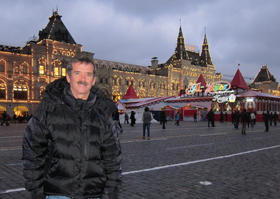
Chris on Moscow's Red Square, December 2, 2012. (Credit: Canadian Space Agency)

The Star City Church. It is located near the cottages where the astronauts live while in training, December 5, 2012. (Credit: Canadian Space Agency)
After completing their qualification exams and taking part in ceremonies around Star City and Moscow, the crew of Expedition 34/35 had some time to decompress before leaving for Baikonur, Kazakhstan today. During the past week Hadfield spoke with various North American media, including an interview he did with the CBC about his training and the physical changes he will undergo while in space. Interesting articles were also published this morning on personal items he will bring to space and the "magic" of space.
Upon arriving in Baikonur, Hadfield and his crew mates will take part in several cosmonaut traditions, including flag raising and tree planting ceremonies. As of today, they have less than two weeks before their launch, which will be televised on the CSA website on December 19, at 7:12 a.m. EST.
You can follow the latest mission news on our official Expedition 34/35 Mission Page and through our social media.
November 27–29, 2012

The crew of Expedition 34 (from left): Chris Hadfield, Roman Romanenko, Tom Marshburn. (Credit: NASA)
This week, CSA Astronaut Chris Hadfield, NASA astronaut Tom Marshburn and cosmonaut Roman Romanenko completed their final two exams to qualify for space flight. One exam was held in the Russian mockup of the International Space Station, and the other occurred in the Soyuz simulator. The final eight-hour Soyuz exam included scenarios such as a malfunction of the UHF transmitter and a rapid depressurization of the spacecraft. The crew performed exceptionally well, scoring a perfect five out of five on their exam card.
Today, the trio took part in a number of pre-flight ceremonies. These included signing the guest book in the office of Yuri Gagarin and placing carnations at the site of the Gagarin Memorial Wall in Moscow's Red Square. Next week, on December 6, they will be off to Baikonur, Kazakhstan for more ceremonies and final preparations for their launch on December 19.
